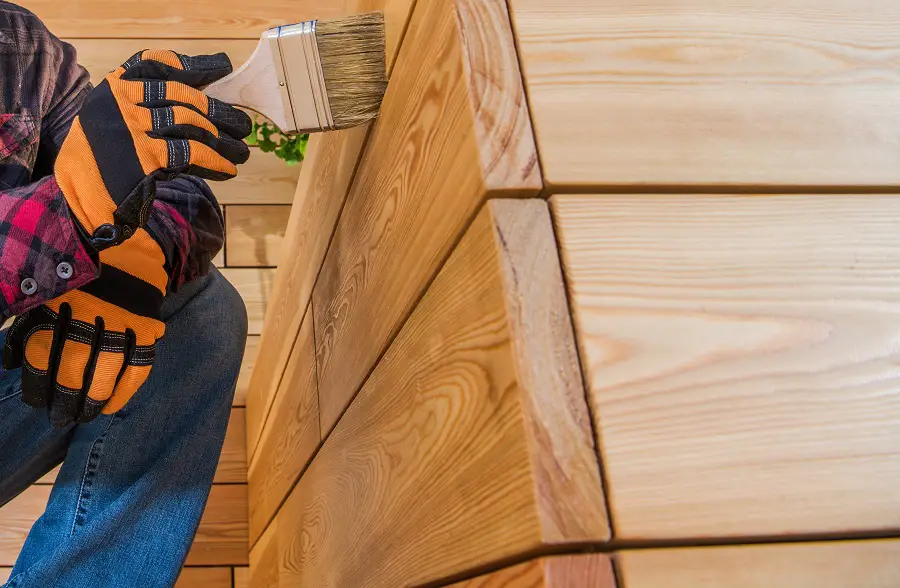What you will find out
It feels like spring is here. The questions we're getting are more and more about exterior finishes and gazebos, fences, pergolas or garden furniture. The preference is for linseed oil, but there are many unknowns about its use, properties and resistance. I am glad to discover, however, the desire for information to do things as correctly as possible. The idea for the article came from finishing a solid wood gate for which I received a very elaborate posting. A series of finishes were proposed, starting from wood burning and covering with linseed oil to various oil-based lacquers or water, accompanied by many questions, especially about linseed oil. We have selected the most frequently asked questions in order to give the necessary answers and explanations.

How do I make wood absorb more oil?
Protection with oils comes from the fact that they enter the wood and protect it from the inside against moisture. The advantage of linseed oil is that it has a smaller molecule than other oils (tung oilfor example), which makes it easier and deeper into the wood. But sometimes it needs a little help. One way is dilution. Use white spirit, petrosin (lamp gas) or, for those who prefer natural and healthy solutions, turpentine - extracted from pine resin - or citrus oil. It is recommended that the first 2 coats be thinned, then reduce the amount of thinner added. Another method of decreasing dilution is heating. This makes the oil more fluid without the inconvenience of extra thinner.
A very good way to increase uptake is wood sanding. The surface of the wood is sanded with 150 or 180 grit sandpaper and the grain is cut, opening several absorption paths. Sanding can also be done 2-3 times before applying the oil layers. Fine sandpaper is not used because it does not have the power to break the wood fibre and the resulting fine dust can close the fibres, blocking absorption.
How do I know the wood has absorbed enough?
Apply excess oil, allow to absorb for 30-45 minutes, then wipe off excess. Linseed oil does not react with oxygen in the air and does not form a film. The excess left unwashed becomes sticky, very unpleasant both in appearance and to the touch. When first applied, the wood will absorb the full amount and it will not be necessary to wipe off the excess. When, after 3-4 coats applied with sanding, the oil remains unabsorbed after 45 minutes, the wood has reached its peak. It will absorb again after a period of use, when weathering and mechanical action will remove some of the absorbed oil.
Why boil linseed oil?
To dry faster. Natural, unprocessed linseed oil dries very slowly. It can take a week to a month before the surface of the wood no longer looks and behaves wet. To speed up the process, the linseed oil is boiled. In the past, lead compounds were added to this process to increase the oil's polymerisation capacity, causing it to dry faster. Now lead compounds are no longer used because they are dangerous (lead is a heavy metal). The oil is boiled for several hours at very high temperatures and in the absence of oxygen. The result is a natural compound that is darker, more viscous than the original product and dries much faster.
What is Sicativated Linseed Oil?
It is an oil whose drying time is reduced by chemical compounds called siccatives. Sicatives are generally cobalt compounds. The oil undergoes a thermal process in which these siccatives are added, which greatly reduces the drying time.
Why is the use of coloured linseed oil recommended?
Linseed oil, unlike tung oil, is not resistant to UV radiation. It protects the wood against moisture, but cannot protect it against the sun. This is why wood treated with plain, uncoloured oil can change colour over time, taking on the grey tinge of wood that has been left unprotected outside. To make it resistant to the sun's rays, a quantity of pigment is added to the linseed oil. This is basically the recipe for oil-based outdoor lacquers. The quantity is not large - around 5% - so the oil remains transparent, or rather semi-transparent. The pigments are meant to deflect the sun's rays so they don't end up affecting the wood.

Can oiled wood be coated with varnish or paint?
Oiled wood can only be coated with oil-based paints or alkyd varnishes and paints. A filming product will prolong the life of the finish as it will be an extra deterrent to water. But the wood can also be left with just oil varnish (lightly pigmented oil) provided the refinishing is done more often. The life of protected objects is greatly increased if the water does not puddle on the surface and if they do not stand directly in the rain and are protected with awnings or eaves.
How resistant is linseed oil on the outside? How long does it take to re-oil and how do I know it's time?
Linseed oil is not very resistant on the outside. The thin molecule and the fact that it does not form a film allows water to wash it off more easily than tung oil, for example. That's why in outdoor products, linseed oil is used in mixtures with other oils, natural or synthetic. The resistance over time depends very much on how much rain falls in the area, how well the object is protected, how well the water drains off and how well the natural ventilation is done to dry the water. Linseed oil does not protect wood against mould growth and therefore great care must be taken when stagnating water.
Sometimes, if conditions are difficult, re-soiling should be done every 6 months. Usually it is done every 1-2 years. The sign that maintenance needs to be done is the dry appearance of the wood, without that oily sheen that remains immediately after finishing. If it is not re-sanded immediately, the wood starts to turn grey and mould can appear, blackening it in places.
ATTENTION! During the drying process, the oil reacts with oxygen in the air, and the reaction is heat releasing. This can lead to self-combustion, i.e. the ignition of waste and oil-soaked rags used in application. It is recommended that all such debris, utensils or used rags be placed in an empty paint can with water in it and the can covered with a lid. The ignition process is accelerated by the sun's rays (the sun gets on these oil residues).
I hope you find this information helpful. If you have any additions, queries or questions, please leave them in the space below. I will certainly reply.






























Add comment